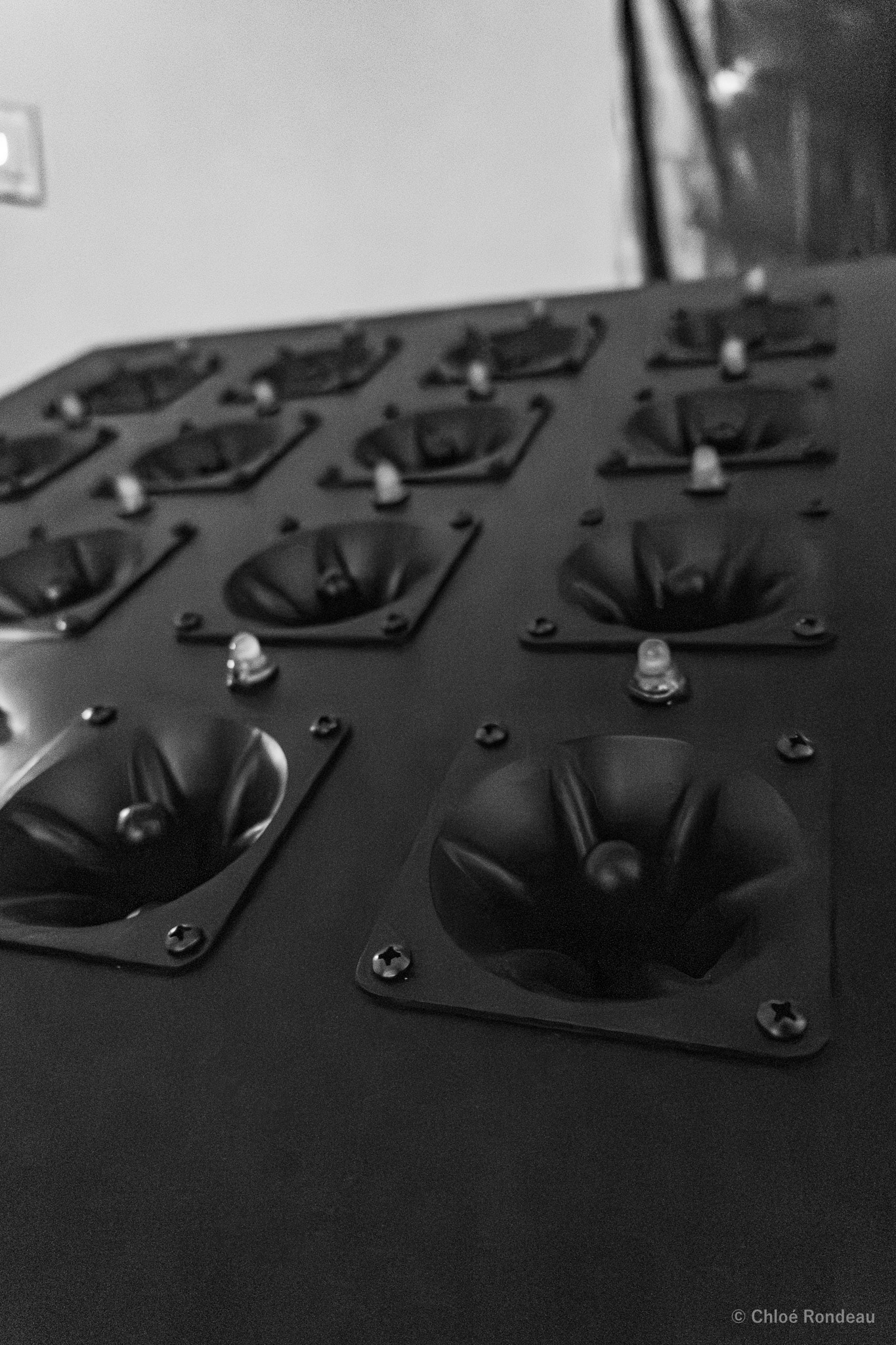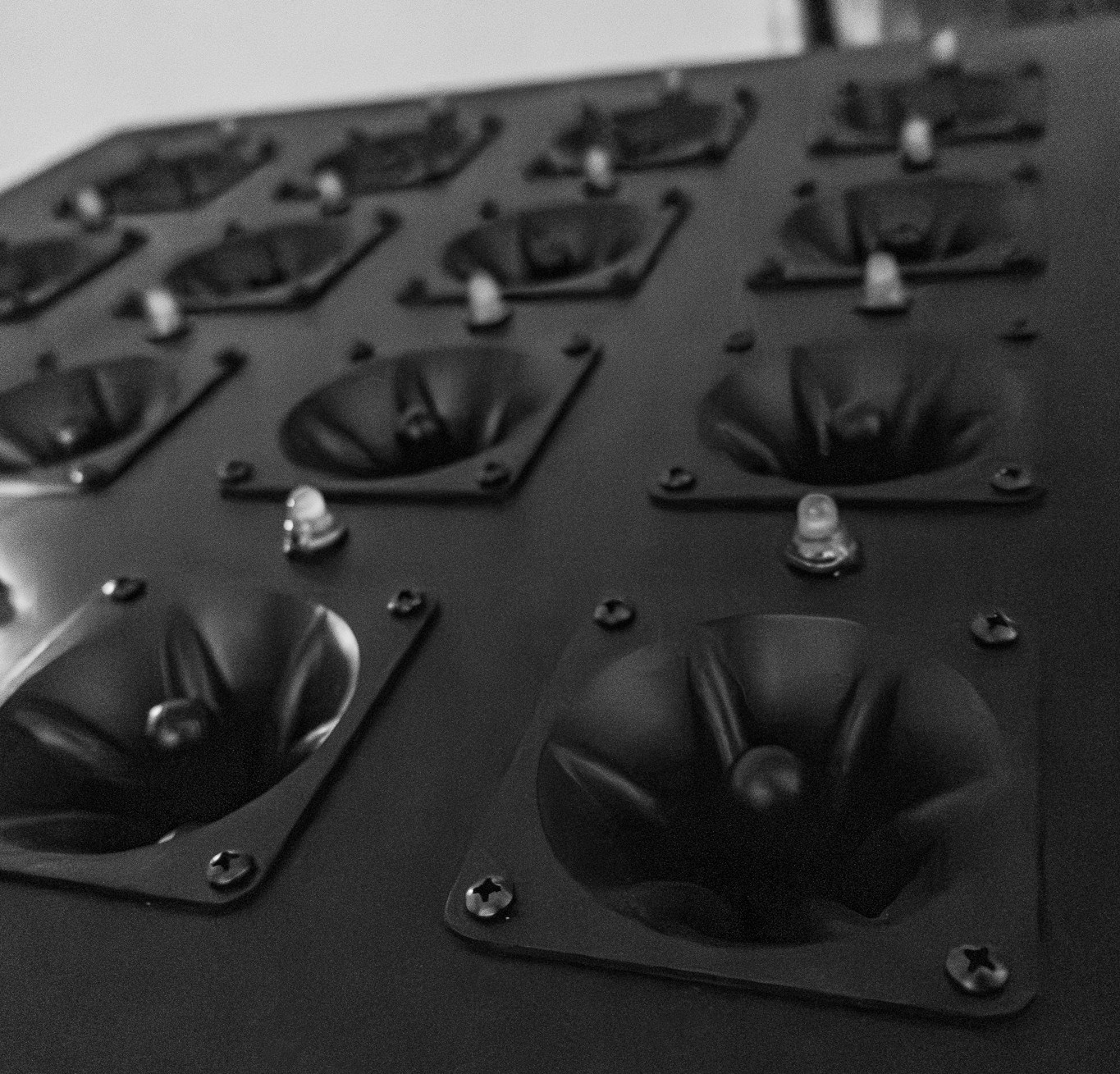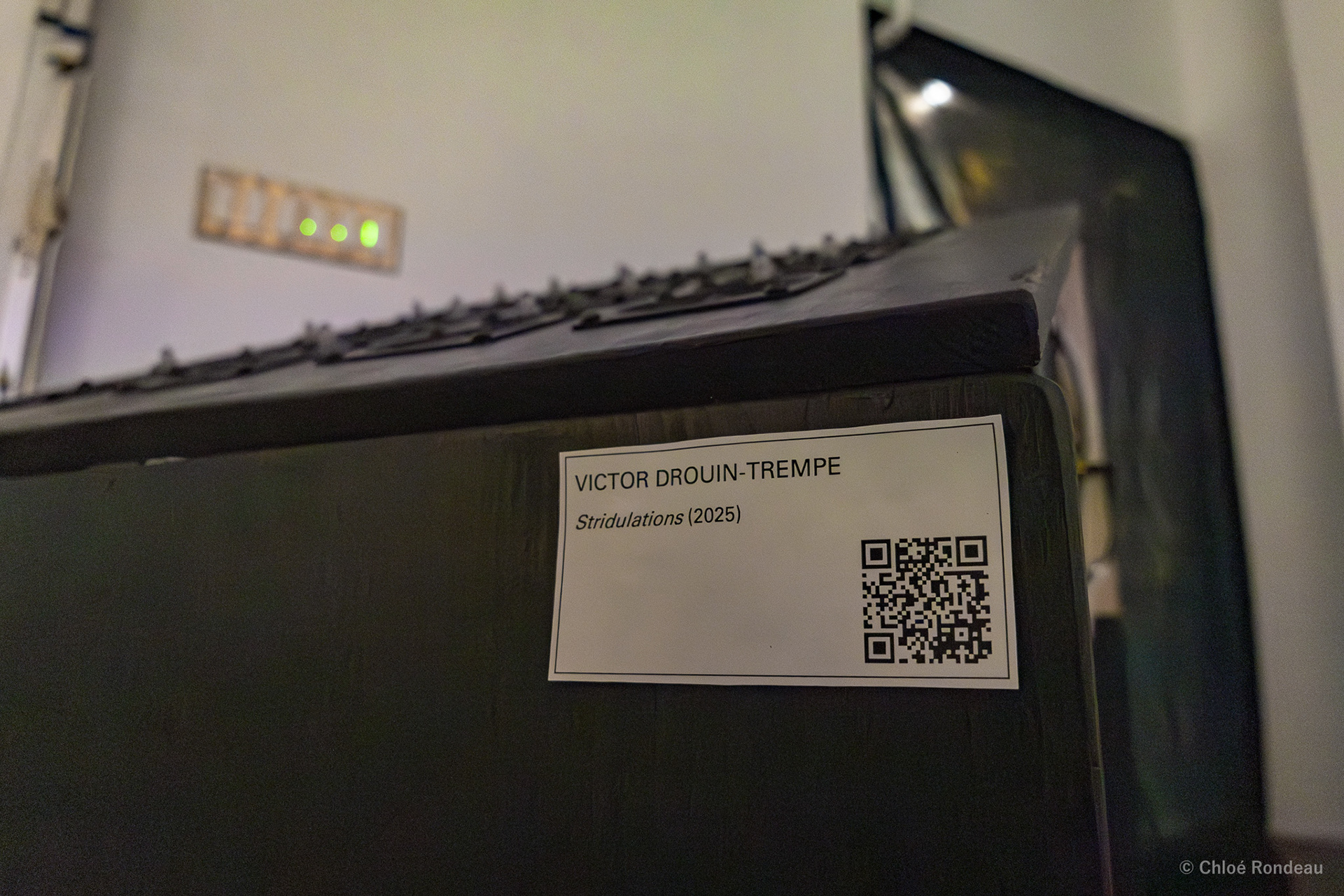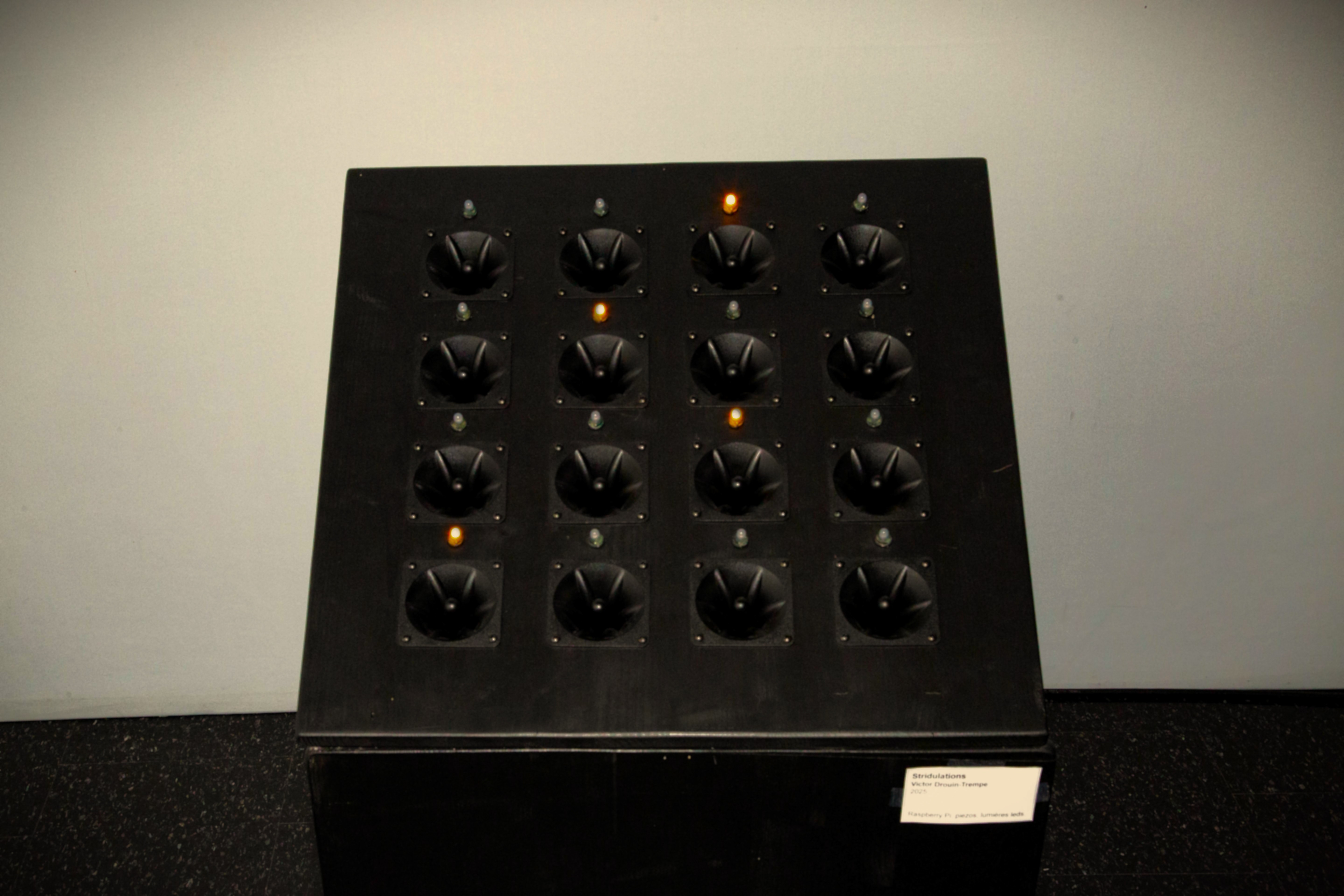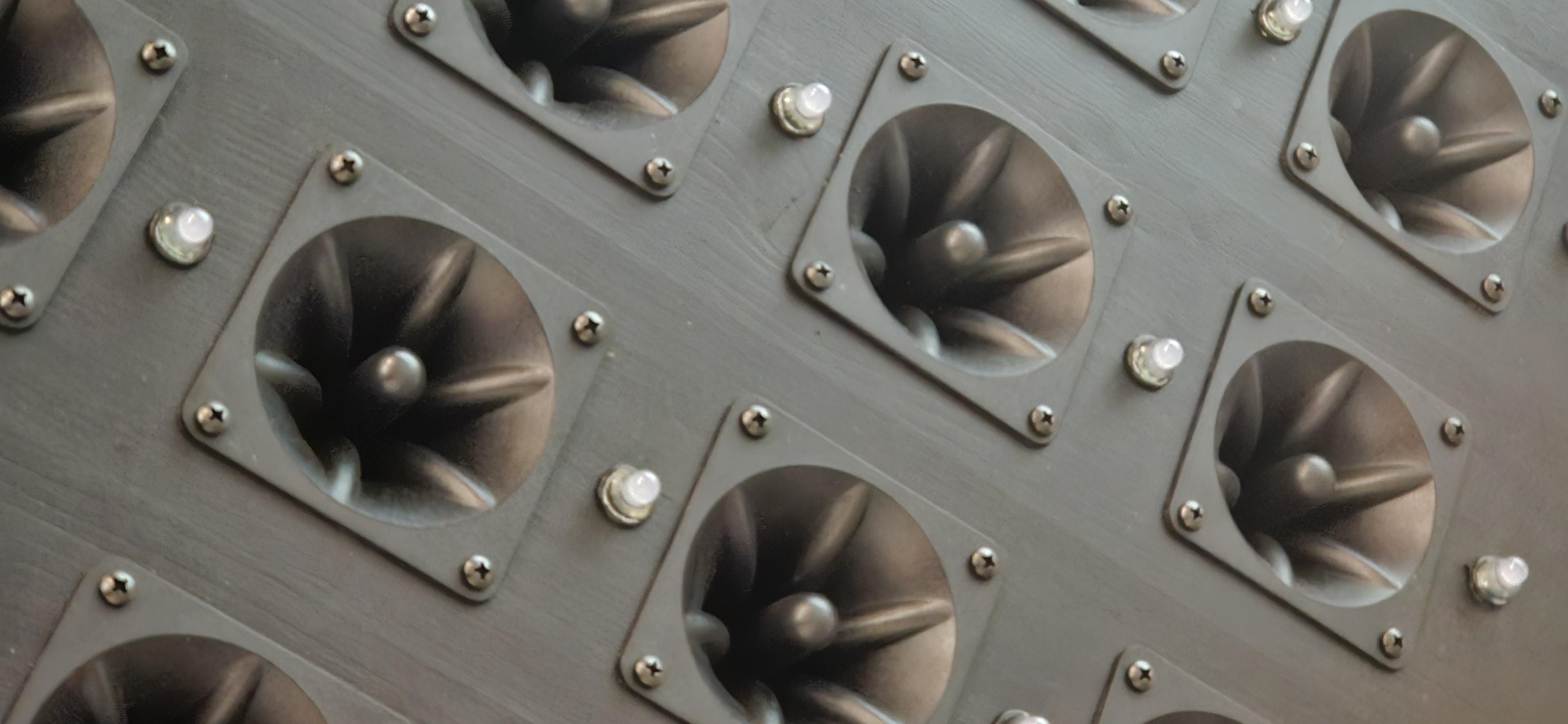Les grillons chantent aux heures chaudes de l’été québécois, tissant un paysage sonore en perpétuelle mutation. Chaque individu possède son propre rythme, une structure singulière que l’on peut discerner en portant attention à un seul chant. Mais dès que ces rythmes s’entrelacent, ils génèrent des motifs polyrythmiques mouvants, oscillant entre stabilité et transformation. Ce jeu d’accumulations et de croisements fait émerger une trame rythmique qui ne se réduit à aucun de ses éléments isolés, mais qui naît précisément de leur interaction.
L’installation « Stridulations » rend hommage à cette polyrythmie vivante. Seize haut-parleurs diffusent chacun le chant d’un unique grillon. En s’approchant d’un haut-parleur, l’écoute se focalise sur la pulsation propre à un seul grillon; en s’éloignant, les sons se superposent et forment une trame sonore dense et hypnotique, où chaque motif individuel se fond dans un enchevêtrement plus vaste. L’espace d’écoute oscille alors entre la perception du détail et l’immersion dans l’ensemble.
Mais ce paysage sonore n’a pas été capté dans un champ ou une forêt. Chaque chant de grillon est une production synthétique, créée à l’aide de synthétiseurs virtuels qui reproduisent fidèlement les stridulations naturelles. Ce faisant, l’installation ne se contente pas d’imiter un écosystème sonore : elle le reconstruit artificiellement, révélant la manière dont un phénomène perçu comme naturel peut être reconstitué par des processus technologiques. Ainsi, l’authenticité de l’expérience ne tient pas à l’origine biologique du son, mais à la manière dont il est entendu et interprété.
Pour souligner les structures rythmiques émergentes, un dispositif lumineux accompagne le son : une lumière est placée au-dessus de chaque haut-parleur, s’activant en synchronie avec le chant qu’il émet. Lorsque l’installation est plongée dans l’obscurité, elle devient une partition vivante où les sons et les lumières s’entrelacent, donnant à voir autant qu’à entendre l’entrelacement des rythmes.
« Stridulations » questionne notre manière de percevoir le vivant en révélant la porosité entre le naturel et l’artificiel. En recréant un phénomène sonore que l’on associe spontanément à la nature, l’installation nous confronte à une forme de vie synthétique, où le rythme et l’organisation du son suffisent à évoquer une présence vivante.
Crickets sing in the warm hours of a Quebec summer, weaving a constantly changing soundscape. Each individual has its own rhythm, a singular structure that can be discerned by paying attention to a single song. But as soon as these rhythms intertwine, they generate shifting polyrhythmic patterns, oscillating between stability and transformation. This interplay of accumulations and crossovers gives rise to a rhythmic framework that is not reduced to any single element, but is born precisely from their interaction.
The “Stridulations” installation pays tribute to this living polyrhythm. Sixteen loudspeakers each broadcast the song of a single cricket. As you approach a loudspeaker, the listener focuses on the pulsation of a single cricket; as you move away, the sounds overlap to form a dense, hypnotic soundtrack, in which each individual motif blends into a larger tangle. The listening space oscillates between the perception of detail and immersion in the whole.
The “Stridulations” installation pays tribute to this living polyrhythm. Sixteen loudspeakers each broadcast the song of a single cricket. As you approach a loudspeaker, the listener focuses on the pulsation of a single cricket; as you move away, the sounds overlap to form a dense, hypnotic soundtrack, in which each individual motif blends into a larger tangle. The listening space oscillates between the perception of detail and immersion in the whole.
But this soundscape wasn't captured in a field or forest. Each cricket song is a synthetic production, created using virtual synthesizers that faithfully reproduce natural stridulations. In so doing, the installation doesn't simply imitate a sound ecosystem: it reconstructs it artificially, revealing how a phenomenon perceived as natural can be reconstituted by technological processes. In this way, the authenticity of the experience lies not in the biological origin of the sound, but in the way it is heard and interpreted.
To underline the emerging rhythmic structures, a lighting device accompanies the sound: a light is placed above each loudspeaker, activating in synchrony with the song it emits. When the installation is plunged into darkness, it becomes a living score in which sound and light intertwine, making the interweaving of rhythms as visible as they are audible.
“Stridulations” questions the way we perceive living things, revealing the porosity between the natural and the artificial. By recreating a sound phenomenon we spontaneously associate with nature, the installation confronts us with a synthetic form of life, where the rhythm and organization of sound are enough to evoke a living presence.
To underline the emerging rhythmic structures, a lighting device accompanies the sound: a light is placed above each loudspeaker, activating in synchrony with the song it emits. When the installation is plunged into darkness, it becomes a living score in which sound and light intertwine, making the interweaving of rhythms as visible as they are audible.
“Stridulations” questions the way we perceive living things, revealing the porosity between the natural and the artificial. By recreating a sound phenomenon we spontaneously associate with nature, the installation confronts us with a synthetic form of life, where the rhythm and organization of sound are enough to evoke a living presence.
